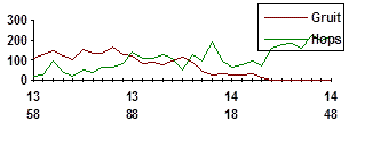Medieval Ale and Beer (or The Rise of the Hop)
The common conception of the medieval brewer conjures up the image of a middle-aged Alewife, attending to a boiling cauldron of malted barley within the small confines of the peasant home. It is probably safe to say that nearly half of the homes in Northern Europe during this period did at least some brewing of their own. This being the case, the image of the Alewife would indeed be common, but in order to meet the needs of the medieval populace a growing industry was supplementing her production.
Any discussion of medieval diet and nutrition would be incomplete without reference to ale and beer. The reasons for their being consumed in such great quantity are many, but one of the foremost is that there was perhaps no other single item so readily available and nutritious (except bread, which is composed of nearly the same ingredients). Before progressing further I wish to point out that during this period the difference between ale and beer was that beer included the addition of hops, a practice which grew in popularity from the 14th century on.
The nutritive qualities of these beverages were more substantial than their mass produced modern counterparts. The presence of yeast supplied the drinker with a great source of B-complex vitamins, necessary for the metabolization of food into usable energy and to maintain fluid levels in the body. The base of a cereal grain, usually barely, provided carbohydrates, proteins and fiber. Although they were obviously not aware of these particulars, they were nevertheless contributing to their well being by partaking regularly.
Perhaps just as important as the nutritional value was the availability of the beverages. The ingredients of ale were water, barley and yeast. Water was easily obtained and if it was not the most pure the boiling process would rectify this. Barley was grown in most areas of Northern Europe as were other cereal grains, for the production of bread and beer. Yeast could not be cultivated for controlled use as it is today, but the practice of spontaneous fermentation by the use of natural airborne yeast was usually sufficient to begin the process. In addition to barley the use of rye and wheat were also common although neither lent itself to fermentation as completely as barley. Prior to the addition of hops there were mixtures of dried herbs and bog myrtle used to flavor ales. This was known as gruit, it was not easily found and as its use became more popular it came under government control and taxation.
This element of taxation has provided records, which enable us to track the growth of the brewing industry. By the 13th century monasteries, town governments and laymen were making payments for gruit grants to the emperor. The use of gruit can be traced to the Low Countries and areas of the Rhine Valley but there is no evidence of its use in England. The use of hops was becoming more common by the beginning of the 15th century. Originally restricted to the areas of Northern Germany the market for hopped beer spread rapidly to Holland and later to England. A survey of tradesmen in Hamburg in 1376 shows that over 40 percent of them were brewers and nearly half this number brewed exclusively for the export market. Rulers that held the right to tax gruit often attempted to stop the import or production of hopped beer in their own lands. Once this was seen to be a futile effort they began to tax the import of hopped beer and eventually the hops themselves. This was accompanied by a simultaneous decline in the production of ale spiced with gruit. The chart below illustrates the obvious correlation between the decline in the use of gruit and the increased use of hops.
The information in this graph is taken from tax records in the Dutch town of Leiden and is representative of the whole of Northwest Europe. What is not conclusive about the information is the question of whether the use of gruit ceased completely at this time or became so inconsequential that it was no longer taxed. Although the addition of hops instead of gruit did not affect the nutritive qualities of the products it did have another affect which was to prove significant. It was discovered that when boiled with the malted barley, the hop secreted a bitter, oily substance that not only complimented the sweetness of the malt but also acted as a preservative! This effectively increased the life of beer by three or four times. Brewers realized the benefits of producing greater quantities with each brew, and specialization led to industrialization. As early as 1404 the average size of a brew in Utrecht was 3,100 liters, a far cry from an Alewife's batch! Within a century this number would nearly double. With growing specialization and production there was increased availability and decreased costs, both to the producer and the consumer. This was a benefit to most people, taverns, inns and monasteries began to receive their supplies from commercial brewers and the overall quality of the product increased. Not only did this alleviate the Alewife's need to produce her own but it also eliminated for her the possibility of procuring cash income through the sale of her products to local establishments.
Despite the fact the drinking of alcoholic beverages is condemned by many extremists today, there is very little evidence of alcoholism during this period. Quantities of consumption among the common people did of course vary greatly, figures given for the North German city of Hamburg are 310 liters per person in 1475, with this amount rising to 700 liters in 1615. Although this amount would be considered high today (despite the fact that most beer is now weaker) it was undoubtedly a staple of the medieval diet.
© C. Renegar Jr.
